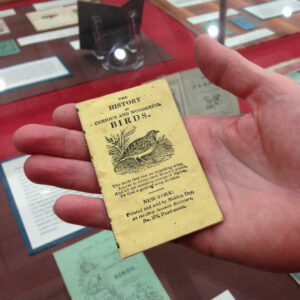Nial Willems
Whether one was a precocious child, a naughty grown-up with a taste for the scandalous, or some other wretched creature trapped in between, one’s experience with literature during the 16th through 19th centuries in Britain was likely to be well informed by the popular formats known as broadsides and chapbooks. Thought by some to be derived from the word “cheap”, “chap”-books and the similar single-sided, single-page publications known as broadsides, from which chapbooks developed, were widely distributed and immensely popular forms of literary ephemera during the pre-industrialized printing era (“Broadsides and Chapbooks”). Largely comparable to modern-day newspapers, tabloids and billboards in function, the formats assumed by chapbooks and broadsides are similarly indicative of the time and cultural context in which they arose, being highly adaptable for the conveyance of both the informational and the entertaining.
As a collective format, broadsides and chapbooks are significant for the historical context they help to illuminate about their time of prominence (Morrison). Between detailing crime convictions, announcing public executions, soapboxing on the daftness of vaccination, and making accessible to lower-class citizenry renowned works of song and literature, this kind of cheap literature proved critical to the encoding and dissemination of then-contemporary British culture (Archer).
In one broadside titled “Are You Vaccinated” and originally published by H. Disley, smallpox vaccination—a relatively new medical practice for the day (“Jenner, Edward”)—is given the satirical treatment by a lengthy tongue-in-cheek ballad. Of the 76 lines in this work, 48 are dedicated to providing the reader a comprehensive insight about just who—and what—was at risk of vaccination; citing Napoleon, “the monument on Fish Street Hill”, and even “the devil himself”, the composer frames the fad as all-consuming and utterly inescapable. Furthermore, he comments that vaccination has “turned his wife’s brain” so that she behaves like a monkey and “brays just like a donkey”, playing on the common fear of vaccines as unproven and dangerous. Following this charitable characterization, the writer offers in jest a final challenge for the reader to seek vaccination. While it certainly makes for a fun read today, the flippant sense of humour present in this broadside is also emblematic of a popular style used in early print ephemera which made broadsheets and chapbooks suitable as commercial formats for both packaging cheap laughs and promulgating ideas.

Scale of a typical chapbook compared to a human hand. Image source: http://news.library.mcgill.ca/wp-content/uploads/2014/04/history-of-birds.jpg
Key to the success of this cheap literature was—no doubt—its cheapness, which made it accessible to a far broader cross-section of the British population than the standard full-size book (dschapman). Cost-effectiveness was achieved through the use of low-quality paper, simple but enticing (though not always relevant) woodcut images, a general absence of extraneous decoration, and cheap labour—provided primarily by women and children, or subcontracted to lower class-families for domestic production (Richardson). The simplicity afforded by only imposing onto a single page further economized mass-production. Moreover, early chapbooks were often sold directly to consumers as single, folded sheets, with the trimming and sewing tasks left to the purchaser, should it have been desired (dschapman). Once folded thrice, the typical octavo chapbook contained 16 pages and featured dimensions of approximately 6” x 4” (Richardson), while broadsides “ranged from approximately 13″ x 16″ (‘foolscap’size) to over 5 feet in length” (Gartrell). The minimal use of material and the resulting compact scale of both formats lent them well to the task of economically mass-publicizing individual events, decrees, short-form literature, and, especially, tales of scandal—whether invented, true or a combination of both (dschapman).